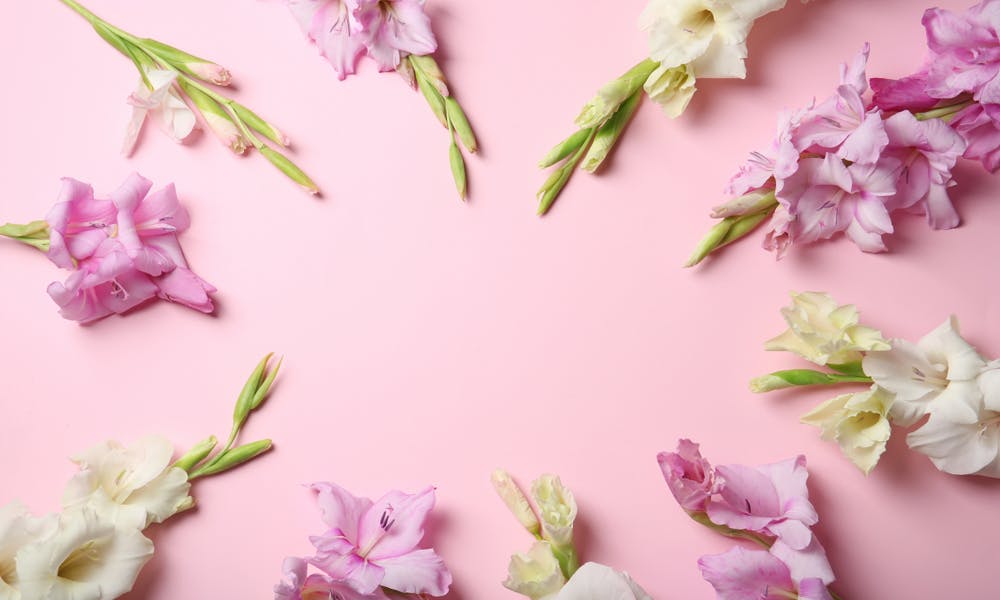MENU
The Gladiolus Flower

Also known by the name the sword lily, the gladiolus flower is a member of the Iris family of flowering plants. These spectacular looking flowers, very similar to orchids in appearance, have a broad range of colors ranging from white to burgundy to green. Very common in wedding bouquets, you can find them indoors adding zest to homes and outdoors in elegant garden displays. From ancient African medicinal use to its sword-like appearance connecting it with the gladiators of old, the gladiolus has been gracing the world stage for centuries, if not millennia. We are going to explore its origins, details and all the fun facts we can in this article.
Keep on reading to find out:
- The History of the Gladiolus Flower
- Flower Facts
- Symbolism in Culture
- Use in Cuisine and Medicine
- Growing Your own Gladiolus Flower
- Taking Care of Your Corms
The History of the Gladiolus Flower
The gladiolus, a part of a genus of perennial flowering plants, is a member of the Iridaceae family. Native to many parts of the world such as the savannahs, woodlands, and grasslands of southern Africa, the Mediterranean, and other parts of Asia. Stemming from only seven species, there are now close to 300 species within the genus. Around 260 of the species are found within Africa with only a small handful being found in Europe. It is thought to have been found originally in the 1820s in KwaZulu natal, although there are varying reports.
Flower Facts
A perennial herbaceous plant, the gladiolus flower grows not from a true bulb but from a corm, a sort of bulbous tuber. The inflorescences can bear anywhere from one to a few flowers. They typically have stems with one to nine sword-shaped, grooved leaves. Known for their very large, lopsided spikes with two large, leathery bracts, the flower generally has three stamens and has tepals. There a variety of hybrids in existence now, with colors such as whites, greens, reds, pinks, purples, burgundy, and blues having been cultivated throughout the years. Most of the species were pollinated by long-tongued bees until recently when other animals such as flies, sunbirds, and moths began to pollinate them as well.
Symbolism in Culture
The gladiolus, from the Latin term for a gladius, a sword used in ancient times, is a flower that has come to symbolize both strength and moral integrity for centuries due to its connection to gladiators. Also known as the sword lily, or xiphium in ancient times, which also means sword. A gift of a bouquet of gladioli to another can represent the givers’ passion and infatuation of the other. It is said to also be the flower to represent lovers’ 40th wedding anniversary and can be found in many bouquets celebrating the occasion. Gladioli have also come to symbolize both faithfulness and sincerity. It is the official birth flower of the month of August.
Use in Cuisine and Medicine
The gladiolus has a very bland, neutral flavor somewhat resembling vegetables such as lettuce. It is often used as a bedding for sweet or sometimes creamy mousses and spreads. You can toss petals into salads or cooked with mixed vegetables for enhanced flavor. The corm can be boiled and leached in water to be used as a starchy food source. A widely used part of the African medicine tradition, the gladiolus was often used in the treatment of a variety of sicknesses such as diarrhea, constipation, and colds. Some cultures use it to treat hypochondriacs, and to improve mood and energy levels. Others use it to treat lumbago and for relief from headaches. Some of the species have been known to cause skin irritation and allergic reactions when handled.
Growing Your Own Gladiolus Flower
When thinking to grow your own gladiolus flower, the best way to start is with larger, fuller corms. The flower grows well in full sun or with some partial shade. Although perennials, they can be grown as annuals in cooler areas, being pulled in fall and stored inside until the next spring. In areas where winters are dry, the flowers can be allowed to stay. Relatively small, you can grow many plants within a small space. Blooming season is in late summer around when other flowers tend to wilt, allowing the gladiolus to really fill in the vacant spaces. Well-drained, sandy soil is best, with support being added so that the flowers don’t fall over. Adding some compost before planting and fertilizing the soil at different stages of growth can be beneficial. The gladiolus does not need to be trimmed or cut throughout its growing season.
Taking Care of Your Corms
To make sure the corms have the maximum chance of germinating, make sure to remove any and all weeds growing nearby. The gladioli thrip, a small, black insect, is one of the main threats to gladioli growth, as it drains the nectar of the plants dry and can cause deformations within the flower. If you notice a thrip infestation, make sure to spray with a good fungicide. If you happen to choose to store the corms for the next season, leave at least 1 inch of the stem after cutting. Store at a cool temperature, leaving them within a box or container filled with peat. Divide the corms and clean them well before storing them.
Do not use water for cleaning, simply brush off with your fingers gently or use a small comb. The corms that are best taken care of can give you the very best results when you grow them.
The Proud Gladiolus
This striking flower, herald of strength and integrity, has been gracing gardens and homes for centuries now. Whether you wish to have it around for its fascinating ties to the powerful and ancient gladiators, or simply due to its stunning variety and beauty, the gladiolus can be a worthy addition to any household.

